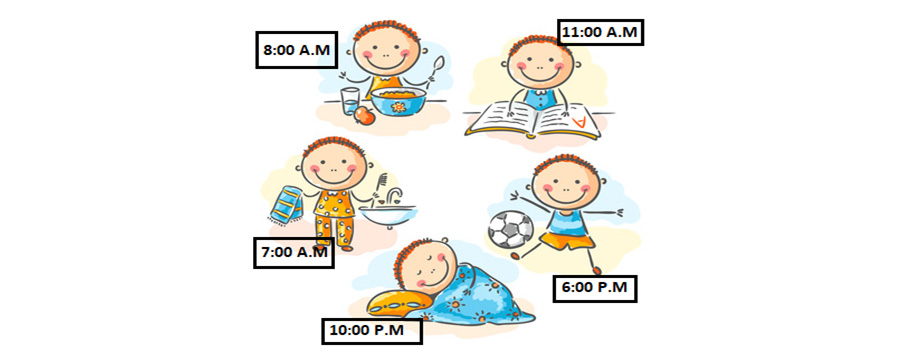Time
- In math, time can be defined as the ongoing and continuous sequence of events that occur in succession, from the past through the present to the future.
- Time is a used to quantify, measure or compare the duration of events or the intervals between them, and even, sequence events.
Here, a child’s daily routine events have been put in sequence according to the time at which they are done.


We measure time in seconds, minutes, hours, days, weeks, months and years with clocks and calendars.
A day has 24 hours.


Clock:
We measure and define what time of the day it is using clocks. A clock in general has 12 numbers written on it, from 1 to 12. It has an hour hand, and a minute hand. The time is usually based on 12-hour clock.


Units of Measurement:
| Unit | Length, Duration and Size |
|---|---|
| Second | 1 sec |
| Minute | 60 seconds |
| Hour | 60 minutes |
| Day | 24 hours |
| Week | 7 days |
| Month | 28-31 days |
| Quarter | 3 months |
| Year | 12 months or 365/366 days |
| Leap year | 366 days |
| Biennium | 2 years |
| Triennium | 3 years |
| Quadrennium | 4 years |
| Olympiad | 4-years cycle |
| Lustrum | 5 years |
| Decade | 10 years |
| Score | 20 years |
| Jubilee | 50 years |
| Century | 100 years |
| Millennium | 1,000 years |
Some of the Inventions and Devices for measurement of Time:
| Measuring Tools | Description |
|---|---|
  |
1. A sundial is a device that tells the time of day when there is sunlight by the apparent position of the Sun in the sky. 2. In the narrowest sense of the word, it consists of a flat plate (the dial) and a gnomon, which casts a shadow onto the dial. |
  |
1. Marked candles were used for telling the time in China from the sixth century CE. 2. Candles were used to mark the passage of time from one event to another, rather than tell the time of day. |
  |
1. The water clock appears to have been invented about 1,500 BCE. 2. It was a device which relied on the steady flow of water from or into a container. |
  |
1. Originally, sandglasses were used as a measure for periods of time like the lamps or candles. 2. But as clocks became more accurate, they were used to calibrate sandglasses to measure specific periods of time. |
  |
1. A quartz clock is a clock that uses an electronic oscillator that is regulated by a quartz crystal to keep time. 2. This crystal oscillator creates a signal with very precise frequency, so that quartz clocks are at least an order of magnitude more accurate than mechanical clocks. |
Interesting Facts:
- If you wanted to measure time you could use a watch, clock, hourglass or even a sundial.
- A sundial is a tool that uses the position of the Sun to measure time, typically involving a shadow cast across a marked surface.
- The use of pendulums to accurately measure time was discovered by Galileo Galilei around 400 years ago. A pendulum is a free-swinging weight hanging from a pivot.
- There are 60 seconds in a minute, 60 minutes in an hour and 24 hours in a day.
- 10 years is known as a decade, 100 years is known as a century and 1000 years is known as a millennium.
- Milliseconds, microseconds and nanoseconds are examples of very small units of time.
- Scientists believe the moon was used as a form of calendar as far back as 6000 years ago. Calendars have been changing ever since and are very accurate in modern times.
- Many places use daylight saving time (typically by putting clocks forward an hour) for longer daylight in the evenings.
- Different parts of the world are located in different time zones. This means that while you are having breakfast in the morning, someone in another part of the world is having dinner.







